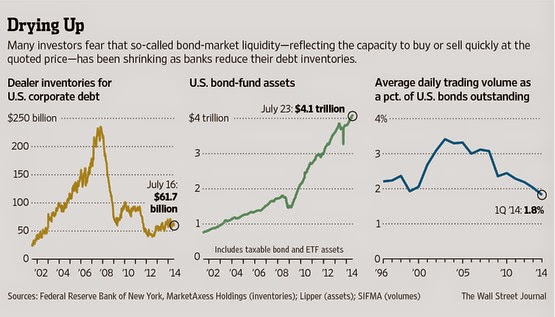According
to RBS, retail investors now own an astounding 37% of the credit market.
This has grown from 29% in 2007, significantly in conjunction with the
growth of mutual funds and ETFs. As I have discussed in this blog over
the last few weeks, the liquidity in the market has not kept pace with the
relentless demand for yield. Off the charts issuance in the primary
market has created a complete misconception about perceived liquidity in the
secondary market, where high yield bonds actually trade.
While
US bond fund assets have grown from approximately $1 trillion in 2003 to nearly
$4.1 trillion today, dealer inventory has fallen off a cliff. Peak
inventory in early 2008 was nearly $250 billion. Today, US corporate
dealer inventory is $61.7 billion, with average daily trading volume in US
corporates dipping below 2% of all outstanding debt for the first time since
the late 1990's. Specifically, high yield corporate inventory fell to
$4.8 billion in early July, the lowest level since the Fed started publishing
this data in April 2013.
Banks
have been forced to eliminate or repurpose most of their prop-desks and their
risk-taking activities have been largely curtailed. Post 2008 crisis,
banks now face must stricter capital requirements, where the appetite to hold
the riskiest securities on their balance sheet is suppressed. Market
participants are finding out fast that the bid is difficult to hit when selling
bonds, even in small size.
For
the week ended August 6th, investors pulled a record $7.1 billion from US junk
bond mutual funds and ETFs. In the last four weeks, the redemptions have
totaled $12.6 billion, trumping the $12.3 billion pulled in Q2-2013's
"taper tantrum". The high yield bond market, which typically
trades with a very high correlation to the stock market, is starting to
diverge. The overheated credit market and its growing bubble have now
gotten the attention of the media, with daily headlines suggesting caution.
With interest rates set to move higher, taper almost complete and QE
being wound down, high profile investors and economists are letting themselves
be heard by sending out warnings. Corporate bankruptcy expert, Dr. Ed
Altman, published research earlier this week which discusses the nature and
risks in the current credit bubble. For full disclosure, Dr. Altman is an
advisor to our Fund.
Let
us also not forget the following: 1) There are serious military actions
occurring in the Middle East as we speak - that the US is now involved in, 2)
several airplanes carrying innocent civilians have recently either mysteriously
disappeared or have been shot down, 3) the Fed recently announced that
inflation is unlikely to continue running below the 2% target, 4) the 2nd
largest bank in Portugal just effectively collapsed, and 5) Argentina just had
its 2nd technical default in the last 15 years. In the summer of 2011
(the last real market correction), the S&P 500 fell nearly 20%, primarily
on a spike in anxiety about Europe's ongoing sovereign debt crisis,
specifically with Greece teetering on the edge of default, and the US
government's inability to agree on the debt ceiling, which ultimately resulted
in a credit rating downgrade.
We
are facing an environment where market technicals can turn very quickly, both
for the positive and negative. While I have consistently written about,
and discussed with most of you, that the poor fundamental health in many of the
B and CCC-rated bonds we are short of will be the ultimate driver of downward
bond prices, the technical considerations in the market are quite important and
compelling today. I urge investors to seriously consider adjusting their
exposures, to be proactive rather than reactive and to take advantage of the
asymmetry present in being short high yield today.
Enjoy
your Sunday. I'm in the Pocono Mountains with my in-laws - fishing,
playing with the dog, watching the kids play, but thinking about high yield
bonds!!!
Richard Travia
Director of Research


No comments:
Post a Comment